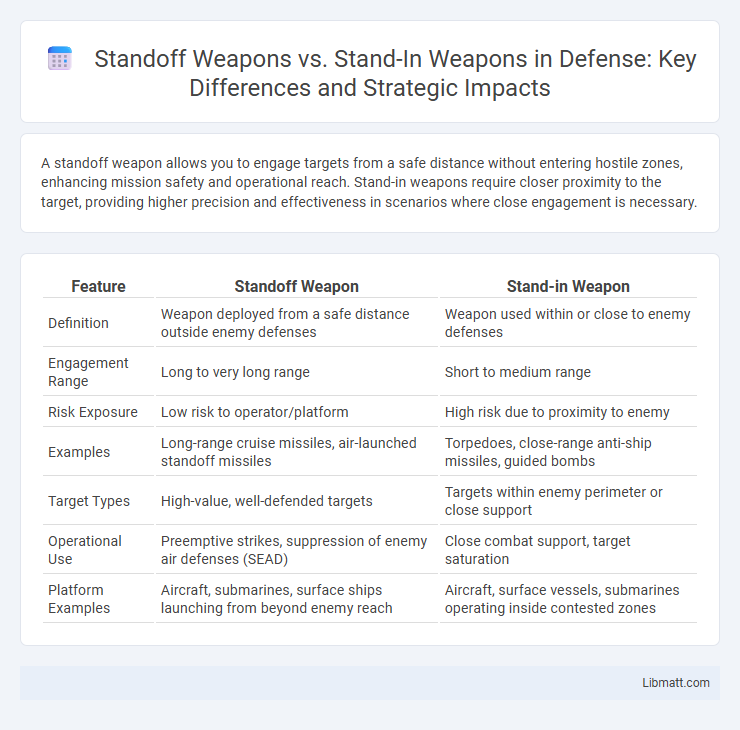A standoff weapon allows you to engage targets from a safe distance without entering hostile zones, enhancing mission safety and operational reach. Stand-in weapons require closer proximity to the target, providing higher precision and effectiveness in scenarios where close engagement is necessary.
Table of Comparison
| Feature | Standoff Weapon | Stand-in Weapon |
|---|---|---|
| Definition | Weapon deployed from a safe distance outside enemy defenses | Weapon used within or close to enemy defenses |
| Engagement Range | Long to very long range | Short to medium range |
| Risk Exposure | Low risk to operator/platform | High risk due to proximity to enemy |
| Examples | Long-range cruise missiles, air-launched standoff missiles | Torpedoes, close-range anti-ship missiles, guided bombs |
| Target Types | High-value, well-defended targets | Targets within enemy perimeter or close support |
| Operational Use | Preemptive strikes, suppression of enemy air defenses (SEAD) | Close combat support, target saturation |
| Platform Examples | Aircraft, submarines, surface ships launching from beyond enemy reach | Aircraft, surface vessels, submarines operating inside contested zones |
Overview of Standoff and Stand-in Weapons
Standoff weapons are designed to be launched from a safe distance, allowing platforms to engage targets without entering hostile air defense zones. Stand-in weapons require closer proximity to the target, often operating within contested environments to deliver precision strikes. Both types optimize mission effectiveness by balancing range, survivability, and target accuracy depending on tactical needs.
Defining Standoff Weapons: Capabilities and Applications
Standoff weapons are precision-guided munitions designed to engage targets from significant distances, minimizing exposure to enemy defenses and increasing operational safety. These weapons typically feature extended ranges, advanced guidance systems such as GPS or inertial navigation, and the ability to strike high-value or heavily fortified targets without direct line-of-sight. Applications include air-to-surface missiles, cruise missiles, and long-range artillery, providing strategic advantages in modern warfare by allowing forces to neutralize threats while remaining outside hostile engagement zones.
Stand-in Weapons: Key Features and Roles
Stand-in weapons operate within contested environments, designed for precision strikes at closer ranges while evading advanced enemy defenses. These weapons often possess advanced guidance systems, electronic countermeasures, and the capability to loiter near target areas, enabling real-time target updates and flexible mission execution. Your strategic use of stand-in weapons enhances operational effectiveness by allowing engagement of high-value targets that require proximity and adaptability.
Range and Engagement Differences
Standoff weapons typically offer extended engagement ranges, allowing platforms to strike targets from a safe distance beyond enemy defenses, often exceeding 100 kilometers. Stand-in weapons operate at shorter ranges, designed for closer proximity engagements, usually within 50 kilometers, enabling precise targeting in contested environments. The primary difference lies in the tactical employment: standoff weapons favor risk avoidance with long-range engagement, while stand-in weapons emphasize penetration and accuracy in high-threat zones.
Deployment Platforms: Air, Land, and Sea
Standoff weapons are designed for long-range deployment from air, land, and sea platforms, enabling You to engage targets while remaining outside enemy defense zones, such as cruise missiles launched from aircraft or ships and long-range artillery from ground vehicles. Stand-in weapons operate closer to the battlefield and are typically deployed from manned or unmanned air vehicles, ground forces, or naval vessels to provide precision strikes within contested areas. The strategic use of these weapon types across multiple platforms enhances mission flexibility and tactical advantage in diverse combat environments.
Survivability and Risk Assessment
Standoff weapons enhance survivability by allowing you to engage targets from a safe distance, minimizing exposure to enemy defenses and reducing risk to personnel and assets. Stand-in weapons require closer proximity, increasing the likelihood of detection and targeting by adversaries, thus elevating operational risk. Effective risk assessment weighs mission objectives against these survival trade-offs to optimize weapon deployment strategies.
Technological Innovations in Standoff and Stand-in Weapons
Technological innovations in standoff weapons emphasize extended range, precision guidance, and stealth capabilities, enabling strikes from safe distances while minimizing detection. Stand-in weapons benefit from advancements in autonomous targeting systems, enhanced sensor fusion, and real-time data link integration, allowing them to operate within contested environments and support close-range engagements. Your strategic advantage increases by leveraging these cutting-edge technologies to optimize mission effectiveness across diverse combat scenarios.
Tactical Advantages and Limitations
Standoff weapons enable forces to engage targets from extended distances, reducing exposure to enemy air defenses and increasing survivability in contested environments. Stand-in weapons, flown closer to the target, provide higher accuracy and can exploit real-time battlefield data for dynamic targeting but face greater risk from surface-to-air threats. Both weapon types complement each other tactically by balancing range, precision, and risk, yet limitations include dependence on platform stealth for standoff weapons and vulnerability for stand-in weapons during ingress.
Operational Scenarios: Use Cases and Examples
Standoff weapons are deployed in operational scenarios requiring engagement of targets from long distances, such as missile strikes against enemy air defenses or strategic infrastructure, minimizing risk to the launch platform. Stand-in weapons operate within contested environments where close-range precision strikes are necessary, exemplified by drones infiltrating enemy airspace to neutralize high-value assets with reduced exposure. Your mission planning should consider the threat environment and target proximity when choosing between stand-off capabilities for distant suppression and stand-in options for close-in engagements.
Future Trends in Standoff and Stand-in Weapon Systems
Future trends in standoff and stand-in weapon systems emphasize increased autonomy, enhanced sensor fusion, and network-centric warfare integration to improve target identification and engagement accuracy at extended ranges. Advances in artificial intelligence and machine learning enable adaptive decision-making and real-time threat assessment, reducing reliance on human operators and increasing mission success rates. Hypersonic propulsion and stealth technologies are also driving the evolution of standoff and stand-in weapons, enabling rapid penetration of contested airspace and improved survivability against emerging air defense systems.
Standoff weapon vs Stand-in weapon Infographic

 libmatt.com
libmatt.com